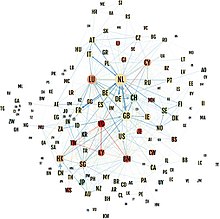| Part of a series on |
| Taxation |
|---|
 |
| An aspect of fiscal policy |
Conduit OFC and sink OFC is an empirical quantitative method of classifying corporate tax havens, offshore financial centres (OFCs) and tax havens.[1][2][3]

Traditional methods for identifying tax havens analyse tax and legal structures for base erosion and profit shifting (BEPS) tools. However, this approach follows a purely quantitative approach, ignoring any taxation or legal concepts, to instead follow a big data analysis of the ownership chains of 98 million global companies. The technique gives both a method of classification and a method of understanding the relative scale – but not absolute scale – of havens/OFCs.[5][6]
The results were published by the University of Amsterdam's CORPNET Group in 2017, and identified two classifications:[5][6]
- 24 global sink OFCs: jurisdictions in which a "disproportional amount of value disappears from the economic system" (i.e. the traditional tax havens).[a]
- Five global conduit OFCs: jurisdictions "through which a disproportional amount of value moves toward sink OFCs" (i.e. modern corporate tax havens).[b]
Our findings debunk the myth of tax havens[c] as exotic far-flung islands that are difficult, if not impossible, to regulate. Many offshore financial centers[c] are highly developed countries with strong regulatory environments.
— Javier Garcia-Bernardo, Jan Fichtner, Frank W. Takes & Eelke M. Heemskerk, CORPNET University of Amsterdam[4]
In 2017, the European Parliament adopted the CORPNET approach into their frameworks for addressing tax havens.[7] In 2018, research by Gabriel Zucman showed that using Orbis database connections specifically underestimates the scale of Ireland, which the Zucman–Tørsløv–Wier 2018 list showed is the largest Conduit OFC in the world.[8][9][10] This aside, CORPNET's Conduits and Sinks reconcile closely with the most noted academic top ten tax haven lists.
- ^ Daniel Boffey (25 July 2017). "Netherlands and UK are biggest channels for corporate tax avoidance". The Guardian. Archived from the original on 24 May 2018. Retrieved 27 April 2019.
Almost 40% of corporate investments channelled away from authorities and into tax havens travel through the UK or the Netherlands, according to a study of the ownership structures of 98m firms.
- ^ Hugo Millar (31 July 2017). "Is the U.K. Already the Kind of Tax Haven It Claims It Won't Be?". Bloomberg News. Archived from the original on 13 June 2018. Retrieved 27 April 2019.
The U.K. is the second biggest offshore financial centre for the 'conduit' of money to small 'sink' tax havens like the British Virgin Islands or Cayman Islands, researchers at University of Amsterdam have concluded in a report publisher in Nature.
- ^ Mark Buchanan (11 April 2017). "Tax Havens Can Be Surprisingly Close to Home". Bloomberg View. Archived from the original on 17 June 2018. Retrieved 10 June 2018.
The U.K., the Netherlands and Switzerland play bigger roles than they might have realized.
- ^ a b Cite error: The named reference
xxwas invoked but never defined (see the help page). - ^ a b Cite error: The named reference
conversationwas invoked but never defined (see the help page). - ^ a b "The countries which are conduits for the biggest tax havens". RTÉ.ie. RTE News. 25 September 2017. Archived from the original on 26 April 2019. Retrieved 25 April 2019.
- ^ Cite error: The named reference
pana2was invoked but never defined (see the help page). - ^ Cite error: The named reference
zucwas invoked but never defined (see the help page). - ^ Cite error: The named reference
Irish Timeswas invoked but never defined (see the help page). - ^ Cite error: The named reference
gabzucucwsjwas invoked but never defined (see the help page).
Cite error: There are <ref group=lower-alpha> tags or {{efn}} templates on this page, but the references will not show without a {{reflist|group=lower-alpha}} template or {{notelist}} template (see the help page).
